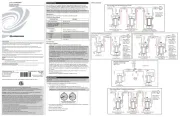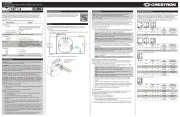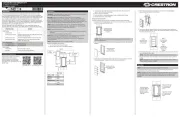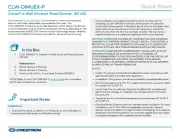Paladin 673 833 rf Handleiding
Bekijk gratis de handleiding van Paladin 673 833 rf (2 pagina’s), behorend tot de categorie Dimmer. Deze gids werd als nuttig beoordeeld door 26 mensen en kreeg gemiddeld 4.7 sterren uit 13.5 reviews. Heb je een vraag over Paladin 673 833 rf of wil je andere gebruikers van dit product iets vragen? Stel een vraag
Pagina 1/2

Potencia Máxima 275VA
Máxima Corriente de Absorción 1/10V 500mA
Máxima Corriente de Inyección 1/10V 250mA
Nº Máximo de Pulsadores Ilimitado (no admite luminosos)
Dimensiones
Peso 35g
Tª Funcionamiento 0ºC ~ +40ºC
Tª Almacenamiento -30ºC ~ +70ºC
Grado de Protección IP20 según UNE20324
De Acuerdo a la Norma UNE-EN60669-2-1
Bornas de Conexión Tipo “ascensor”.
Hasta 6mm2 de sección de cable
Radio-Frecuencia Emisión codificada en 868,3MHz
Alcance: < 100m (campo abierto)
Compatible con Sensores KNX-RF: 676 010 rf,
673 010 rf, 670 010 rf
46 x 46 x 30mm
ES
REGULADOR INALÁMBRICO KNX-RF PARA EQUIPOS 1/10VCC
ESPECIFICACIONES TÉCNICAS
DESCRIPCIÓN
Regulador inalámbrico para el control de Reactancias o Drivers 1/10V.
Compatible con el protocólo KNX-RF.
Montaje empotrado en caja de registro.
Incorpora un potenciómetro que permite ajustar la velocidad de regulación (Fig. 2).
Compatible con los emisores: 676 010 rf, 673 010 rf, 670 010 rf.
Posibilidad de control a través de pulsador cableado:
· Pulsación corta: enciende o apaga.
· Pulsación larga: regula hacia arriba o hacia abajo.
Función Memoria (opcional).
CARACTERÍSTICAS
Incorpora un selector de modos (Fig. 1) para la programación de enlaces y configuración:
· P: programación de un enlace del canal receptor.
· R: funcionamiento normal con con función repetidor.
· S: funcionamiento normal.
· E: borrado de un enlace del canal receptor.
· EA: borrado de todos los enlaces de los canales transmisor y receptor.
Un segundo potencíómetro (Fig, 2) permite seleccionar la velocidad de regulación:
· -: velocidad de regulación lenta.
· +: velocidad de regulación rápida.
Dispone de tecla de Programación “PROG” para el enlace con otros dispositivos.
Es posible conectar un pulsador auxiliar cableado para el control local de la carga.
Dispone de 2 canales RF: canal de salida (pulsador cableado) y canal de entrada.
INSTALACIÓN
!!!Desconecte la alimentación antes de instalar, reemplazar o manipular el equipo
eléctrico!!!
Realice el cableado siguiendo uno de los 3 esquemas.
· Fig. 3: Instalación sencilla.
· Fig. 4: Instalación sencilla con pulsador cableado (opcional).
· Fig. 5: Instalación con contactor.
ESQUEMA DE INSTALACIÓN
NOTA: No olvide conectar la Tierra ( ) de la Reactancia para evitar posibles
fluctuaciones en la iluminación.
La conexión del pulsador auxiliar es opcional. Dependerá de si su instalación requiere de un
pulsador de control local de la carga conectada al regulador o de si se requiere el control
remoto, vía RF, de otro u otros mecanismos receptores RF asociados.
EA
E
S
RP
Poder de Corte del Relé 250VCA / 1,2A
Nº Máximo de Equipos 100 (*)
Tipo de Carga Reactancias o Drivers 1/10Vcc
Consumo < 5W
Tensión Alimentación 230V~ 50/60Hz
Abb. 1 Abb. 2
GB
1-CHANNEL 1-10 VDC DIMMER WIRELESS
KNX-RF COMPATIBLE
TECHNICAL DATA
DESCRIPTION
Wireless dimmer switch for Fluorescence or LED lighting fixture with 1/10V Ballast or Driver.
Compatible with RF-KNX media.
Unidirectional and Broadcasting communication. Individual addressing is not allowed.
Flush mounting into junction box.
Built-in dimming speed selector knob.
Compatible with transmitters: 676 010 rf, 673 010 rf, 670 010 rf.
Can also be controlled by a wired pushbutton:
· Brief press: switch on/off.
· Sustained press: dimming up/down.
Optional Memory function.
CHARACTERISTICS
Built-in mode selector knob (Fig. 1) for the link programming and commissioning:
· P: link programming.
· R: standard operation with repeater function.
· S: standard operation.
· E: one link deletion from the receiver channel.
· EA: all links deletion from the receiver and transmitter channel.
Dimming speed selector knob (Fig, 2):
· -: slow dimming speed.
· +: fast dimming speed.
Programming key “PROG” for the link process.
An external wired pushbutton can be installed for the local control of the load.
Two RF channels: output channel (wired pushbutton) and input channel (dimmer).
INSTALLATION
!!! Switch off the mains before installing, removing or handling of electrical
equipment!!!
Install the dimmer according to one of the 3 wiring diagrams:
· Fig. 3: Simple electrical installation.
· Fig. 4: Simple electrical installation with wired pushbutton (optional).
· Fig. 5: Installation with contactor.
WIRING DIAGRAM
NOTE: Do not forget to install the earth cable ( ) of the ballast or driver.
The connection of the external wired pushbutton is optional. It depends if the installation
requires wired pushbutton control or onle with a wireless transmitter.
Maximum load 275VA
Max. Input Current 1/10V 500mA
Max. Output Current 1/10V 250mA
Maximum number of pushbuttons Unlimited (without glow lamp)
Dimensions
Weight 35g
Working temperature 0ºC ~ +40ºC
Storage temperature -30ºC ~ +70ºC
Environmental protectio IP20 (EN60529)
According to the Standard EN60669-2-1
Connection terminals “Lift” type.
Up to 6mm2 wire
Radio-Frequency Codified transmission in 868,3MHz
Range: < 100m (in the free field)
Compatible with KNX-RF Sensors: 676 010 rf, 673 010 rf,
670 010 rf
46 x 46 x 30mm
Breaking capacity 250VAC / 1,2A
Maximum number of equipments 100 (*)
Suitable type of lighting fixture 1/10VDC Ballasts or Drivers
Power consumption < 5W
Supply voltage 230V~ 50/60Hz
Abb. 3
1/10V
Ballast
or Driver
L
N
-
+
L
N
230V~ 50/60Hz
1/10V
Ballast
or Driver
L
N
-
+
NP
V+
V-
L’ L
No Mem
Mem
673 833 rf
230V~ 50/60Hz
(*): Para determinar el número máximo exacto de reactancias o drivers que se pueden
conectar al regulador es necesario saber la máxima Corriente de Absorción o de
Inyección del equipo de la luminaria por la señal 1/10V.
Ejemplo: Disponemos de un Driver que consume 2mA por la entrada 1/10V:
Nº Máx. Equipos
Máx. Corriente Inyección RE PLA 010
Consumo de Entrada 1/10V del Driver
=250mA
2mA =125 Equipos
Además del consumo por la entrada 1/10V, es necesario tener en cuenta que, en caso
de realizar el ejemplo de la Fig. 3, el consumo de las luminarias.
En caso de superar 1,2A es necesario intercalar un Contactor entre L’ y la alimentación
del las luminarias (Fig. 4). Ejemplo:
Disponemos de un Driver de 20W y cosφ=0,9: 275VA / (20W / 0,9) = 12 Drivers máximo
=
(*): To calculate the maximum number of Ballasts or Drivers that can be connected to the
dimmer it is necessary to know the Maximum Input or Output Current of the 1/10V input
from the lighting fixture.
Example: We have a Driver which consumes 2mA through its 1/10V input:
Max. Equipments
Max. Output current of 673 833 rf
1/10V Driver Input Consumption
=250mA
2mA =125 Equipments
In the case of doing the wiring from the Fig. 3, besides the consumption by the 1/10V
input, it is necessary to take into account the consumption of the lighting fixture. If the
consumption is higher than 1,2A it would be necessary to install a Relay between L’ and
the supply of the lamps (Fig. 5). Example:
We have a Driver of 20W & cosφ=0,9: 275VA / (20W / 0,9) = 12 Drivers maximum
=
673 833 rf Max. Last 275VA
Max. Eingangsstrom 1-10V 500mA
Max. Ausgangsstrom 1-10V 250mA
Max. Anzahl anschließbarer Taster Unbegrenzt (unbeleuchtet)
Abmessungen
Gewicht 35g
Betriebstemperatur 0ºC ~ +40ºC
Lagertemperatur -30ºC ~ +70ºC
Schutzart IP20 (EN60529)
Angewandte Norm EN60669-2-1
Anschlussart Schraubklemmen (Aufzugsklemmen)
bis 6mm2 Leitungsquerschnitt
Funkfrequenz Verschlüsselte Übertragung, 868,3MHz
Reichweite: < 100 m (auf freiem Feld)
Kompatibel mit Sender: 676 010 rf, 673 010 rf,
670 010 rf
46 x 46 x 30mm
DE
1-KANAL 1-10VDC FUNK DIMMER (KNX-RF KOMPATIBEL)
TECHNISCHE DATEN
BESCHREIBUNG
Es handelt sich bei diesem Gerät um einen KNX-RF kompatiblen Dimmer für
Leuchtstoff- und LED-Lampen mit 1-10 V Steuereingang (Vorschaltgerät oder Treiber).
Unidirektionale- und Broadcast-Kommunikation. Einzeladressierung ist nicht möglich.
Geeignet für die Unterputzmontage.
Eingebauter Wahlschalter für die Dimmgeschwindigkeit.
Kompatibel mit folgenden Sendern: 676 010 rf, 673 010 rf, 670 010 rf.
Der Aktor kann ebenfalls mit einem kabelgebundenen Taster gesteuert werden:
· Kurzer Tastendruck: EIN/AUS schalten
· Langer Tastdruck: Dimmen
Optionale Memory-Funktion einstellbar.
SYMBOLERKLÄRUNG / FUNKTION
Betriebsart-Wahlschalter Fig.1 (Abb. 1) für die Verlinkung / Programmierung und
Inbetriebnahme:
· P: Einlernvorgang / Programmiermodus.
· R: Normalbetrieb mit zusätzlicher Verstärker-Funktion (Repeater-Funktion).
· S: Normalbetrieb.
· E: Eine Verbindung aus dem Empfängerkanal löschen.
· EA: Alle Verbindungen aus den Empfänger- und Sendekanälen löschen.
Wahlschalter für die Dimmgeschwindigkeit Fig. 2 (Abb. 2):
· -: Langsame Dimmgeschwindigkeit
· +: Schnelle Dimmgeschwindigkeit
Einlerntaste „PROG“ für den Verlinkungs-/ Programmiervorgang.
Ein Taster kann zur Steuerung der Lampen angeschlossen werden.
2 Funk Kanäle: Ausgangskanal (verdrahteter Taster) und Eingangskanal (Dimmer)
INSTALLATION
!!! Vor Montage- und Installationsarbeiten Spannung freischalten!!!
Dimmer gemäß einer der 3 Abbildungen anschließen:
· Abb. 3: Einfache elektrische Installation.
· Abb. 4: Einfache elektrische Installation mit kabelgebundenem Taster (optional).
· Abb. 5: Installation mit zusätzlichem Relais
ANSCHLUSSPLAN
BITTE BEACHTEN: Schutzerde / Schutzleiter ( ) an das Vorschaltgerät oder den
Treiber anschließen!.
Der Anschluss eines externen Tasters ist optional. Dies hängt davon ab ob in der Installation
ein kabelgebundener Taster oder ein Funksender gefordert wird
Schaltleistung 250VAC / 1,2A
Maximale Anzahl EVG/Treiber 100 (*)
Geeignete Lasttypen 1/10VDC Vorschaltgeräte oder Treiber
Leistungsaufnahme < 5W
Anschlussspannung 230V~ 50/60Hz
(*): Um die maximale Anzahl anschließbarer Treiber / EVG’s zu berechnen, muss der max.
Eingangs- bzw. Ausgangsstrom des 1-10 V Eingangs der Beleuchtung berücksichtigt
werden.
Beispiel: Ein Treiber benötigt 2mA an seinem 1-10V Eingang:
Max.Anz.Treiber
Max. Ausgangsstrom 673 833 rf
Strombedarf 1-10 V Eingang Treiber
=250mA
2mA =125 Geräte
Bei einer Verkabelung gemäß Abb. 3 (Fig. 3) sind, zusätzlich zum Strombedarf des 1-10V
Eingangs, die Verbräuche der Leuchten zu berücksichtigen. Sollte der Verbrauch größer
als 1,2 A sein, ist es notwendig ein Relais zwischen L‘ und der Versorgungsspannung der
Lampen einzusetzen – wie in Abb. 5 (Fig. 5) dargestellt.
Beispiel: Treiber mit 20 W und cos φ = 0,9: 275VA / (20W / 0,9) = 12 Treiber maximal
=

WARNUNG!: Gefährliche Spannung!.
Arbeiten am 230 V-Netz nur von Fachpersonal ausführen lassen!.
Vor Montage und Demontage Netzspannung freischalten!.
BETRIEB
A.- Betrieb mittels kabelgebundenem Taster
Die Steuerung erfolgt mittels einem oder mehreren Tastern (parallel):
· Mit einem kurzen Tastendruck werden die Lampen ein- bzw. ausgeschaltet. Zusätzlich
wird bei jedem Tastendruck ein EIN- oder AUS-Telegramm gesendet.
· Mit einem langen Tastdruck werden die Lampen gedimmt. Sobald der Taster nicht mehr
gedrückt wird, wird der Dimmwert gehalten. Wird der Taster erneut lange gedrückt ändert
sich die Dimmrichtung. Zusätzlich wird bei jedem lagen Tastendruck ein DimCtrl
-Telegramm gesendet.
Der Ausgangskanal 0 des kabelgebundenen Tasters kann bei Tastendruck folgende Objekte
per Funk senden: Info OnOff, OnOff & DimCtrl.
B.- Memoryfunktion
Die Memoryfunktion bietet zwei unterschiedliche Möglichkeiten der Leuchtensteuerung:
· Mem: Beim Einschalten wird die Lampe auf den zuvor gewählten (vor dem letzten
Ausschalten gewählten) Helligkeitswert eingestellt.
· No Mem: Beim Einschalten wird die Lampe auf den maximalen Helligkeitswert eingestellt.
C.- Bedienung über den RF-Empfängerkanal
Die an den Dimmer angeschlossenen Leuchten können über einen verlinkten Funksender
gesteuert werden.
Der Eingangskanal 1 des Aktors ist kompatibel mit folgenden Objekten: InfoOnOff,
InfoDimValue, OnOff, DimCtrl, DimValue, Timed, Forced & Scene.
INBETRIEBNAHME
A.- Verlinken des Empfängerkanals (P)
Um den Empfängerkanal des Dimmers mit dem Senderkanal eines anderen (KNX)-RF
-Gerätes zu verlinken (z.B. Taster, Fernsteuerung, …) gehen Sie folgendermaßen vor:
1.- Betriebsart -Wahlschalter auf Position „P“ stellen. Die grüne LED blinkt langsam.
2.- Einlerntaste (PROG) mit Hilfe einer Büroklammer oder etwas Ähnlichem drücken. Die
grüne LED leuchtet nun konstant. Der Empfängerkanal des Dimmers wartet nun darauf,
die Verbindung mit dem Senderkanal eines anderen (KNX)-RF-Gerätes herzustellen.
3.- Senderkanal des gewünschten (KNX)-RF-Gerätes in den Verlinkungsmodus
stellen (gemäß den Vorgaben des Herstellers).
4.- Wenn die Verbindung erfolgreich war, beginnt die grüne LED zu blinken. Sollte es für
2 Minuten keine Verbindungsversuche geben, beginnt die grüne LED zu blinken und
der Programmier-Modus wird beendet.
5.- Der Dimmer ist betriebsbereit sobald Sie den Betriebsart -Wahlschalter nach
erfolgreichem Verlinken auf die Position „S“ oder „R“ stellen.
B.- Verlinken des Senderkanals (P)
Um den Senderkanal des Dimmers mit dem Empfängerkanal eines anderen (KNX)-RF
-Gerätes zu verbinden:
1.- Empfänger in den Programmier-Modus stellen.
2.- Stellen Sie den Betriebsart -Wahlschalter auf Position „P“. Die grüne LED blinkt langsam.
3.- Einlerntaste (PROG) mit Hilfe einer Büroklammer oder etwas Ähnlichem drücken.
4.- Prüfen Sie am Empfängergerät ob die Verlinkung erfolgreich durchgeführt wurde.
5.- Der Dimmer ist betriebsbereit, sobald der Betriebsart -Wahlschalter nach erfolgreichem
Pairing auf die Position „S“ oder „R“ gestellt wird.
C.- Verlinkung des Empfängerkanal löschen (E)
Um eine Verlinkung zwischen Funk-Sendern und dem Empfängerkanal zu löschen:
1.- Betriebsart -Wahlschalter des Dimmers auf Position „E“ stellen. Die LED blinkt langsam.
2.- Einlerntaste (PROG) mit Hilfe einer Büroklammer oder etwas Ähnlichem drücken. Die
LED leuchtet rot. Der Empfängerkanal des Dimmers wartet nun auf das Signal („unlink“)
vom Senderkanal des anderen Geräts.
3.- Stellen Sie nun den Senderkanal des anderen Geräts in den „Unlink“-Modus (gemäß
den Vorgaben des Herstellers).
4.- Wenn das Löschen der Verbindung erfolgreich war beginnt die LED rot zu blinken.
D.- Alle Verlinkungen der Empfänger- und Senderkanäle löschen (EA)
Um alle Verlinkungen des Dimmers zu löschen:
1.- Betriebsart -Wahlschalter auf Position „RESET“ (EA) stellen. Die rote LED blinkt schnell.
2.- Einlerntaste (PROG) mit Hilfe eines Clips oder etwas Ähnlichem drücken bis die rote
LED dauerhaft leuchtet.
3.- Halten sie die Taste weiter gedrückt bis die LED schnell blinkt.
E.- Verstärker Modus (R)
Der Dimmer kann zusätzlich als Signalverstärker verwendet werden.
Diese Funktion ist besonders in Installationen hilfreich, bei denen es aufgrund einer großen
Distanz zwischen den Geräten zu Problemen mit der Signalabdeckung kommen kann.
Beachten Sie jedoch, dass nicht mehr als drei Signalverstärker in einer Installation
verwendet werden sollten.
Diese Funktion wird aktiviert, indem Sie den Betriebsart-Wahlschalter auf „R“ stellen. Die
restliche Funktionalität wird dadurch nicht beeinflusst.
DE
OPERATION
A.- Operation through the external wired pushbutton
The control will be carried out by means of one or more buttons in parallel:
· With brief press the lamps with be switched On or Off. In addition, whenever a short press
is done, a ON or OFF telegram will be sent in accordance with the switching change.
· A sustained press will dim Up or Down the lamps. As soon as the pushbutton is released,
the dimming level will be kept. If the pushbutton is pressed again, the dimming direction
will change. In addition, whenever a lonk press is done, a DimCtrl telegram will be sent.
Output channel 0 from the wired pushbutton sends the objects: Info OnOff, OnOff & DimCtrl.
B.- Memory function
Memory function allows 2 different ways to turn on the lamps:
· Mem: each time the pushbutton is pressed to turn the lamps on, they will be switched on
to the previous level before being switched off.
· No Mem: each time the pushbutton is pressed to turn the lamps on, they will be switched
on at maximum level.
C.- Operation through its RF receiver channel
The lighting fixtures connected to the 673 833 rf can be controlled wirelessly from a linked
transmitter.
Input channel 1 from the dimmer is compatible with the objects: InfoOnOff, InfoDimValue,
OnOff, DimCtrl, DimValue, Timed, Forced & Scene.
COMMISSIONING
A.- Programming a link with the receiver channel of the dimmer (P)
To link the 673 833 rf with a wireless transmitter (pushbutton, remote control,...):
1.- Set the mode selector knob in programming mode (P). The green LED will blink slowly.
2.- Press the programming key (PROG) briefly with the help of a clip or something similar.
The green LED will be ON. The 673 833 rf is now waiting to receive a link telegram
from the transmitter device.
3.- Set the transmitter device in programming mode, according to the instructions given
by the manufacturer.
4.- If the link process is successful the green LED will start blinking. Otherwise, after 2
minutes without receiving any linking signal, the green LED will start blinking and the
673 833 rf will get off programming mode.
5.- To become 673 833 rf functional set the mode selector knob at “S” or “R” position.
B.- Programming a link with the transmitter channel of the dimmer (P)
To link the 673 833 rf with a wireless receiver:
1.- Set the receiver in programming mode.
2.- Set the 673 833 rf in programming mode (P). The green LED will blink slowly.
3.- Press the programming key (PROG) briefly with the help of a clip or something similar.
4.- If the link process is successful the LED from the receiver will show it in some way.
5.- To become 673 833 rf functional set the mode selector knob at “S” or “R” position.
C.- Deleting a link from the receiver channel (E)
To delete a link from the 673 833 rf with a wireless transmitter (pushbutton, remote
control,...):
1.- Set the mode selector knob in link deletion mode (E). The red LED will blink slowly.
2.- Press the programming key (PROG) briefly. The red LED will be on. The 673 833 rf
is now waiting to receive a unlink telegram from the transmitter device.
3.- Set the transmitter device in programming mode, according to the instructions given by
the manufacturer.
4.- If the deletion process is successful the red LED will start blinking again.
D.- Deleting all links from the receiver and transmitter channels (EA)
To delete all links from the 673 833 rf:
1.- Set the mode selector knob in RESET (EA) mode. The red LED will blink quickly.
2.- Press the programming key (PROG) until the red LED is constantly ON.
3.- Then, the red LED will start to blick quickly again.
E.- Repeater mode (R)
The 673 833 rf can also work as a RF signal repeater.
This function is useful only in those installations where communication problems between
RF devices are detected due to distance. In these cases, a repeater located between both
becomes a useful tool to solve this problem.
It is not recommended to use more than 3 repeaters in the same installation.
The repeater function is activated by setting the mode selector to "R". The rest of the
functionality of the dimmer remains unchanged.
GB
WARNING: Hazardous voltage!.
Work with electrical equipment on the 230V mains must be carried
out only by qualified technicians!.
Switch off the mains before installing, removing or handling of
electrical equipment!.
Abb. 5
1/10V
Ballast
or Driver
L
N
-
+
L
N
230V~ 50/60Hz
1/10V
Ballast
or Driver
L
N
-
+
NP
V+
V-
L’ L
No Mem
Mem
673 833 rf
230V~ 50/60Hz
Relais
Relay
Contactor
Abb. 4
1/10V
Ballast
or Driver
L
N
-
+
L
N
230V~ 50/60Hz
Taster
Pushbutton
Pulsador
1/10V
Ballast
or Driver
L
N
-
+
NP
V+
V-
L’ L
No Mem
Mem
673 833 rf
230V~ 50/60Hz
FUNCIONAMIENTO
A.- Funcionamiento a través de un pulsador cableado
El control se realizará mediante uno o varios pulsadores en paralelo:
· Para encender y apagar las lámparas realizaremos pulsaciones cortas. Además, cada
vez que se realice una pulsación corta, se enviará, vía RF, un mensaje de ON u OFF, en
concordancia con el cambio de estado que realiza la carga local.
· La regulación se hará mediante una pulsación larga del mismo, prolongando la pulsación
hasta que la luz alcance el nivel deseado. En este momento soltaremos el pulsador para
que la lámparas conserven el nivel alcanzado. Si durante la regulación soltamos el
pulsador y volvemos a realizar una pulsación larga el sentido de regulación cambiará.
Además, cada vez que se realice una pulsación larga, se enviará, vía RF, un mensaje
DimCtrl, en concordancia con el cambio de estado que realiza la carga local.
El canal de salida 0 del pulsador cableado envía los objetos: Info OnOff, OnOff y DimCtrl.
B.- Función Memoria
La función Memoria permite dos formas diferentes de encender las lámparas:
· Mem: cada vez que se acciona el pulsador para encender las lámparas, éstas se
encenderán al nivel en que se encontraban antes de ser apagadas.
· No Mem: cada vez que se acciona el pulsador para encender las lámparas, éstas se
encenderán al máximo.
C.- Funcionamiento a través de su canal receptor RF
La carga conectada al 673 833 rf puede gobernarse remotamente, vía RF, desde un
dispositivo transmisor RF programado.
El canal de entrada 1 del regulador responde a los objetos: InfoOnOff, InfoDimValue, OnOff,
DimCtrl, DimValue, Timed, Forced y Scene.
CONFIGURACIÓN
A.- Programación de un enlace del canal receptor (P)
Para realizar un enlace del canal receptor del 673 833 rf con un canal transmisor de un
dispositivo KNX-RF (tecla, mando,...):
1.- Poner el selector de modos en modo programación de enlaces (P). El LED verde
parpadeará lentamente.
2.- Con la ayuda de un clip, presionar brevemente la tecla de Programación (PROG). El
LED verde se quedará encendido fijo. El 673 833 rf se encuentra en estos
momentos en espera de aceptar un enlace de un canal transmisor de un dispositivo RF.
3.- Poner el canal transmisor del dispositivo RF que queremos enlazar en modo
programación de enlaces, de acuerdo a sus instrucciones.
4.- Si el establecimiento del enlace tiene éxito, el LED verde comenzará a parpadear. Si
pasan 2 minutos desde que el 673 833 rf estuviera en modo programación sin
recibir ningún intento de enlace de un posible canal transmisor de un dispositivo RF, el
LED verde comenzará a parpadear, abandonando el modo de programación.
5.- Para que el 673 833 rf vuelva a ser operativo, situar el selector de modos en la
posición “S” o “R”.
B.- Programación de un enlace del canal transmisor (P)
Para realizar un enlace del canal transmisor del 673 833 rf con un canal receptor de un
dispositivo KNX-RF:
1.- Poner el receptor que queremos enlazar en modo programación.
2.- Poner el 673 833 rf en modo programación de enlaces (P). El LED verde
parpadeará lentamente.
3.- Pulsar con un clip, o similar, sobre el pulsador de configuración.
4.- Si el establecimiento del enlace tiene éxito, el LED del receptor lo indicará de alguna
forma.
5.- Para que el 673 833 rf vuelva a ser operativo, situar el selector de modos en la
posición “S” o “R”.
C.- Borrado de un enlace del canal receptor (E)
Para borrar un enlace del canal receptor del 673 833 rf con un canal transmisor de un
dispositivo KNX-RF (tecla, mando,...):
1.- Poner el selector de modos en modo borrado de enlaces (E). El LED rojo parpadeará
lentamente.
2.- Con la ayuda de un clip, presionar brevemente la tecla de Programación (PROG). El
LED rojo se quedará encendido fijo. El 673 833 rf se encuentra en estos momentos
en espera de aceptar un desenlace de un canal transmisor de un dispositivo RF.
3.- Poner el canal transmisor del dispositivo RF que queremos borrar en modo
programación de enlaces, de acuerdo a sus instrucciones.
4.- Si el borrado del enlace tiene exito, el LED rojo comenzará a parpadear nuevamente.
D.- Borrado de todos los enlaces del canal receptor y transmisor (EA)
Para borrar todos los enlaces del 673 833 rf:
1.- Poner el selector de modos en modo RESET (EA). El LED rojo parpadeará rápidamente.
2.- Con la ayuda de un clip, presionar la tecla de Programación (PROG) hasta que el LED
rojo se quede fijo.
3.- A continuación, el LED rojo comenzará a parpadear rápidamente.
E.- Modo Repetidor (R)
El 673 833 rf puede, opcionalmente, realizar la función de repetidor de telegramas RF.
Esta función es útil solo en aquellas instalaciones donde se detecten problemas de
comunicación entre dispositivos RF debido a la distancia. En estos casos, un dispositivo
situado entre ambos, capaz de realizar la función de repetidor, se convierte en una
herramienta útil para solventar este problema.
No se recomienda la utilización de más de 3 repetidores.
La función repetidor se activa colocando el selector de modos en la posición “R”. El resto de
la funcionalidad del regulador permanece inalterada.
ES
ATENCIÓN: ¡Tensión peligrosa!.
¡Los trabajos con equipos eléctricos en la red de 230V, deben de ser
realizados exclusivamente por técnicos cualificados!.
¡Desconecte la tensión de red antes de proceder al montaje,
desmontaje o manipulación del equipo eléctrico!.
Product specificaties
| Merk: | Paladin |
| Categorie: | Dimmer |
| Model: | 673 833 rf |
Heb je hulp nodig?
Als je hulp nodig hebt met Paladin 673 833 rf stel dan hieronder een vraag en andere gebruikers zullen je antwoorden
Handleiding Dimmer Paladin

20 Augustus 2023

20 Augustus 2023

20 Augustus 2023

20 Augustus 2023

20 Augustus 2023

20 Augustus 2023

20 Augustus 2023

20 Augustus 2023

20 Augustus 2023

20 Augustus 2023
Handleiding Dimmer
- Legrand
- Fibaro
- Eurolite
- Berker
- Gira
- Eminent
- GE
- Velbus
- Handson
- Ltech
- InterBar
- Steinel
- Adastra
- Jung
- Grasslin
Nieuwste handleidingen voor Dimmer

13 Mei 2025

13 Mei 2025

1 April 2025

1 April 2025

28 Maart 2025

28 Maart 2025

11 Maart 2025

11 Maart 2025

11 Maart 2025

11 Maart 2025